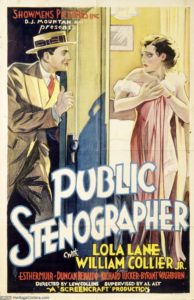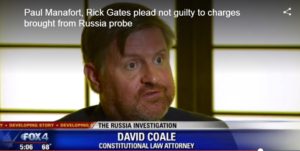 It’s that time of year again. The polls are open until the end of November to vote for next year’s listings of Texas SuperLawyers; online voting can be done at the SuperLawyers website, here.
It’s that time of year again. The polls are open until the end of November to vote for next year’s listings of Texas SuperLawyers; online voting can be done at the SuperLawyers website, here.
Monthly Archives: November 2017
 Appellant filed a notice of appeal about a special appearance that was timely, measured from the ruling on a motion to amend and reconsider, but was not timely, when measured from the original ruling. The Fifth Court found that it was untimely: “The record here reflects the issue in the special appearance was whether the trial court could exercise specific jurisdiction over appellant. Appellant’s motion to amend and reconsider did not present any new arguments. Instead, it cited to decisions issued after the original order was signed, none of which changed the state of the law regarding specific jurisdiction. Because the motion to amend and reconsider presented no new argument, we conclude the amended order denying appellant’s special appearance was not independently appealable and agree with appellees that appellant should have filed its notice of appeal within twenty days of the signing of the original order.” Michelin North America v. Gallegos, No. 05-17-00617-CV (Nov. 21, 2017) (mem. op.)
Appellant filed a notice of appeal about a special appearance that was timely, measured from the ruling on a motion to amend and reconsider, but was not timely, when measured from the original ruling. The Fifth Court found that it was untimely: “The record here reflects the issue in the special appearance was whether the trial court could exercise specific jurisdiction over appellant. Appellant’s motion to amend and reconsider did not present any new arguments. Instead, it cited to decisions issued after the original order was signed, none of which changed the state of the law regarding specific jurisdiction. Because the motion to amend and reconsider presented no new argument, we conclude the amended order denying appellant’s special appearance was not independently appealable and agree with appellees that appellant should have filed its notice of appeal within twenty days of the signing of the original order.” Michelin North America v. Gallegos, No. 05-17-00617-CV (Nov. 21, 2017) (mem. op.)
 The appellant in Abuzaid v. Anani LLC, a user of the venerable AOL email service, alleged that he did not receive notice of a summary judgment hearing. The Fifth Ciurt first noted:
The appellant in Abuzaid v. Anani LLC, a user of the venerable AOL email service, alleged that he did not receive notice of a summary judgment hearing. The Fifth Ciurt first noted:
Texas Rule of Civil Procedure 21a allows for electronic service of documents “if the email address of the party or attorney to be served is on file with the electronic filing manager.” It is undisputed Abuzaid’s email was on file to receive electronic service of documents, and he repeatedly availed himself of the process. . . . The rule does not contemplate that electronic service is somehow incomplete when a party experiences computer or email issues. Rather, notice properly sent pursuant to rule 21a raises a presumption that notice was received.”
(citations omitted). Here, the appellant did not overcome that presumption:
“Under rule 21a, constructive notice may be established if the serving party presented evidence that the intended recipient engaged in instances of selective acceptance or refusal of service of documents. Here, Abuzaid has not denied receiving the January 13, 2016 email attaching the motions for summary judgments and stating, ‘We will notify you via separate correspondence with the hearing date on these motions.’ Further, the record establishes Abuzaid sent and received numerous electronic filings and notices without incident at the email address on file with the trial court up until the day before appellees’ electronically filed their summary judgment motions and notice of hearing. . . . . Given the conflicting evidence, it was within the trial court’s discretion not to believe Abuzaid’s unsupported, self-serving statements about computer issues causing him not to ‘see’ the delivered documents and determine he engaged in selective acceptance of documents.”
No. 05-16-00667-CV (Nov. 21, 2017) (mem. op.)
 While from the Fifth Circuit rather than the Dallas Court of Appeals, a recent case notes a fundamental principle in business litigation under Texas law. In it, that Court affirmed a JNOV motion on damages, under Texas law, when the plaintiff proved gross profits rather than net profits. “Its expert witness testified that he used ThermoTek’s gross profit margin—gross sales, less the cost of those goods sold, divided by gross sales—to calculate lost profits. He then stated that he reached his lost-profit totals for the VascuTherm units and wraps by (1) multiplying the average sales ThermoTek made to Wilford each month by the unit sales price and relevant time period, and (2) deducting the cost of the goods sold. But that is the very definition of gross profits. See Black’s Law Dictionary, supra (defining gross profits as “[t]otal sales revenue less the cost of the goods sold, no adjustment being made for additional expenses and taxes”). Motion Medical Technologies v. Thermotek, No. 16-11381 (Nov. 14, 2017).
While from the Fifth Circuit rather than the Dallas Court of Appeals, a recent case notes a fundamental principle in business litigation under Texas law. In it, that Court affirmed a JNOV motion on damages, under Texas law, when the plaintiff proved gross profits rather than net profits. “Its expert witness testified that he used ThermoTek’s gross profit margin—gross sales, less the cost of those goods sold, divided by gross sales—to calculate lost profits. He then stated that he reached his lost-profit totals for the VascuTherm units and wraps by (1) multiplying the average sales ThermoTek made to Wilford each month by the unit sales price and relevant time period, and (2) deducting the cost of the goods sold. But that is the very definition of gross profits. See Black’s Law Dictionary, supra (defining gross profits as “[t]otal sales revenue less the cost of the goods sold, no adjustment being made for additional expenses and taxes”). Motion Medical Technologies v. Thermotek, No. 16-11381 (Nov. 14, 2017).
 In FC Background LLC v. Fritze, the Fifth Court affirmed the trial court’s conclusion that a merger clause extinguished an arbitration clause in an earlier agreement between the parties. Distinguishing other cases on the general topic, the Court observed that those opinions involved a “subsequent agreement with the merger clause [that] expressly provided for the continued enforceability of prior agreements.” Here, however, the clause “does not contain the limiting language, ‘with respect to the subject matter hereof,’ and thenon-compete agreement incorporates by reference only the December 28 employment agreement but not the employment application that has the arbitration clause sought to be enforced. The merger clause here expressly supersedes any previous written or oral agreements between [the parties] relating to employment.” No. 05-17-00277-CV (Nov. 16, 2017) (mem. op.) (emphasis in original).
In FC Background LLC v. Fritze, the Fifth Court affirmed the trial court’s conclusion that a merger clause extinguished an arbitration clause in an earlier agreement between the parties. Distinguishing other cases on the general topic, the Court observed that those opinions involved a “subsequent agreement with the merger clause [that] expressly provided for the continued enforceability of prior agreements.” Here, however, the clause “does not contain the limiting language, ‘with respect to the subject matter hereof,’ and thenon-compete agreement incorporates by reference only the December 28 employment agreement but not the employment application that has the arbitration clause sought to be enforced. The merger clause here expressly supersedes any previous written or oral agreements between [the parties] relating to employment.” No. 05-17-00277-CV (Nov. 16, 2017) (mem. op.) (emphasis in original).
 A challenge to AAA’s notice of hearing was rejected, and the award confirmed, in Heriage v. BNSF Logistics: “The record shows the AAA sent notice of the May 4th arbitration hearing to appellants on two occasions via both electronic and certified mail––one was approximately two months before the hearing; the other six days before the hearing. The written notices were sent to the physical address listed in the agreement, and the electronic notices were sent to an email address that Herriage admitted he conducted business from in the past but that he no longer bothered to check and had never closed.” 05-16-01232-CV (Nov. 17, 2017) (mem. op.)
A challenge to AAA’s notice of hearing was rejected, and the award confirmed, in Heriage v. BNSF Logistics: “The record shows the AAA sent notice of the May 4th arbitration hearing to appellants on two occasions via both electronic and certified mail––one was approximately two months before the hearing; the other six days before the hearing. The written notices were sent to the physical address listed in the agreement, and the electronic notices were sent to an email address that Herriage admitted he conducted business from in the past but that he no longer bothered to check and had never closed.” 05-16-01232-CV (Nov. 17, 2017) (mem. op.)
 The Texas Lawbook has a good story about the recent opinion in H2R Restaurant Holdings LLC v. Rathbun, which affirmed a favorable ruling for our firm’s client in a temporary injunction dispute.
The Texas Lawbook has a good story about the recent opinion in H2R Restaurant Holdings LLC v. Rathbun, which affirmed a favorable ruling for our firm’s client in a temporary injunction dispute.
In Teel v. Sumrow, the Fifth Court reversed and rendered judgment for the defense in a suit for breach of fiduciary duty, finding that limitations had run on the claim as a matter of law. “[W]e note that the letter  Sumrow wrote to Dr. Bray in July 2008 indicates that by that time, Sumrow knew or suspected Teel had engaged in some wrongful conduct to wrongfully deprive Sumrow of money Sumrow believed Teel owed him (‘screw me out of my money’).” As for reasonable diligence, the Court observed: “[I]n financial affairs, many citizens take a good deal on faith – not everyone zealously checks his mail every day or his bank statement every month – but it would not require ‘daily’ or even monthly diligence to discover the injury alleged in this case.” No. 05-16-00840-CV (Nov. 13, 2017) (mem. op.)
Sumrow wrote to Dr. Bray in July 2008 indicates that by that time, Sumrow knew or suspected Teel had engaged in some wrongful conduct to wrongfully deprive Sumrow of money Sumrow believed Teel owed him (‘screw me out of my money’).” As for reasonable diligence, the Court observed: “[I]n financial affairs, many citizens take a good deal on faith – not everyone zealously checks his mail every day or his bank statement every month – but it would not require ‘daily’ or even monthly diligence to discover the injury alleged in this case.” No. 05-16-00840-CV (Nov. 13, 2017) (mem. op.)
 It’s that time of year again. The polls are open until the end of November to vote for next year’s listings of Texas SuperLawyers; online voting can be done at the SuperLawyers website, here.
It’s that time of year again. The polls are open until the end of November to vote for next year’s listings of Texas SuperLawyers; online voting can be done at the SuperLawyers website, here.
 A trial was held, but after the verdict, a bankruptcy caused several years of inactivity before entry of final judgment in 2015. Unfortunately, in the meantime, a significant part of the reporter’s notes had been lost or destroyed. While Tex. R. App. 34.6 can require a new trial in such a situation if the loss occurs through no fault of the appealing party, the Fifth Court found it did not apply here. In Piotrowski v. Minns, the Texas Supreme Court noted that the applicable Government Code provision “authorizes reporters to cull stale notes from their records after three years when no party has requested otherwise,” whcih means that without a specific request from a litigant, “the litigant is not free from fault if the notes are destroyed as the statute authorizes. 873 S.W.2d 368, 371 (Tex. 1993). The Court found that Piotrowski was good law and controlled here, where no such request had been made in the relevant time period. Geeting v. Dyer, No. 05-16-00128-CV (Nov. 7, 2017) (mem. op.)
A trial was held, but after the verdict, a bankruptcy caused several years of inactivity before entry of final judgment in 2015. Unfortunately, in the meantime, a significant part of the reporter’s notes had been lost or destroyed. While Tex. R. App. 34.6 can require a new trial in such a situation if the loss occurs through no fault of the appealing party, the Fifth Court found it did not apply here. In Piotrowski v. Minns, the Texas Supreme Court noted that the applicable Government Code provision “authorizes reporters to cull stale notes from their records after three years when no party has requested otherwise,” whcih means that without a specific request from a litigant, “the litigant is not free from fault if the notes are destroyed as the statute authorizes. 873 S.W.2d 368, 371 (Tex. 1993). The Court found that Piotrowski was good law and controlled here, where no such request had been made in the relevant time period. Geeting v. Dyer, No. 05-16-00128-CV (Nov. 7, 2017) (mem. op.)
 The opinion in 7-Eleven, Inc. v. Cardtronics, Inc. reminds both of the importance of proving irreparable injury to obtain a temporary injunction, and the deferential standard of review if the trial court denies relief. Specially, 7-Eleven alleged that cancellation of a contract involving ATMs would cause business disruption, but the Fifth Court saw the evidence differently:
The opinion in 7-Eleven, Inc. v. Cardtronics, Inc. reminds both of the importance of proving irreparable injury to obtain a temporary injunction, and the deferential standard of review if the trial court denies relief. Specially, 7-Eleven alleged that cancellation of a contract involving ATMs would cause business disruption, but the Fifth Court saw the evidence differently:
“Seltzer’s testimony is nothing more than fear and speculation as to what may occur unsupported by any relevant data. Although the Agreement had been in place for almost ten years, 7-Eleven offered no evidence to show how over-the-counter sales have been impacted by the addition of the ATMs, or as specific to this case, the impact of the Allpoint network. This does not mean 7-Eleven had to prove any specific amount of damage, only that it needed to offer some concrete evidence that damages will in fact occur by something more than Seltzer’s unsupported conclusory opinion. As for Updyke, he testified only that the retailer loses between 65 and 80 percent of those ‘ATM customers, ATM transactions’ over time. He specifically stated he was not referring to over-the-counter sales customers. To the extent 7-Eleven relies on Cardtronics’s promotional material used to retain 7-Eleven’s business, the trial court could have reasonably seen that as nothing more than a sales pitch, not concrete evidence of specific irreparable harm. Under the particular facts before us, we conclude the trial court could have reasonably determined that 7-Eleven’s claim of harm is speculative and that 7-Eleven failed to demonstrate irreparable injury.
No. 05-17-00623-CV (Nov. 10, 2017) (mem. op.)
 In Nu-Build & Assocs. v. Sooners Group, LP, the Fifth Court drove home a recent holding about damages for cost of completion: “We agree because (i) a party seeking completion cost damages in tort and contract cases must prove that those costs are reasonable; and (ii) proof of amounts charged and paid, alone, is no evidence the
In Nu-Build & Assocs. v. Sooners Group, LP, the Fifth Court drove home a recent holding about damages for cost of completion: “We agree because (i) a party seeking completion cost damages in tort and contract cases must prove that those costs are reasonable; and (ii) proof of amounts charged and paid, alone, is no evidence the  payment was reasonable. Because Sooners adduced no evidence that the $3.6 million it paid to complete project was reasonable, we sustain Nu-Build’s fourth issue and [reverse and render].Mustang Pipeline Co., Inc. v. Driver Pipeline Co., Inc., 134 S.W.3d 195, 200–01 (Tex. 2004) (per curiam); 701 Katy Bldg., L.P. v. John Wheat Gibson, P.C., No. 05-16-00193-CV, 2017 WL 3634335, at *9 (Tex. App.—Dallas Aug. 24, 2017, no pet. h.) (mem. op.).
payment was reasonable. Because Sooners adduced no evidence that the $3.6 million it paid to complete project was reasonable, we sustain Nu-Build’s fourth issue and [reverse and render].Mustang Pipeline Co., Inc. v. Driver Pipeline Co., Inc., 134 S.W.3d 195, 200–01 (Tex. 2004) (per curiam); 701 Katy Bldg., L.P. v. John Wheat Gibson, P.C., No. 05-16-00193-CV, 2017 WL 3634335, at *9 (Tex. App.—Dallas Aug. 24, 2017, no pet. h.) (mem. op.).
 In recent years, the U.S. and Texas Supreme Court have been widely recognized as limiting the reach of long-arm personal jurisdiction. While the necessary showing is now more difficult in some case, it is far from impossible, as shown by Colmen LLC v. Santander Consumer USA, In that case, among other “[s]ince . . . 2015 . . . Colmen reached out to Santander in Texas to solicit the purchase of the fifty-two separate installment sales contracts at issue in this lawsuit. As required, for each individual contract, Colmen forwarded its proposed terms and conditions and all contractually required information, including customer credit-related information, to Santander’s offices in Texas.” No. 05-17-00101-CV (Nov. 3, 2017).
In recent years, the U.S. and Texas Supreme Court have been widely recognized as limiting the reach of long-arm personal jurisdiction. While the necessary showing is now more difficult in some case, it is far from impossible, as shown by Colmen LLC v. Santander Consumer USA, In that case, among other “[s]ince . . . 2015 . . . Colmen reached out to Santander in Texas to solicit the purchase of the fifty-two separate installment sales contracts at issue in this lawsuit. As required, for each individual contract, Colmen forwarded its proposed terms and conditions and all contractually required information, including customer credit-related information, to Santander’s offices in Texas.” No. 05-17-00101-CV (Nov. 3, 2017).
 After the commercial, at about 2:30 in this news segment, I offer a couple of thoughts about recent developments in the Russia investigation.
After the commercial, at about 2:30 in this news segment, I offer a couple of thoughts about recent developments in the Russia investigation.